REVIEW: Super Dungeon Explore!
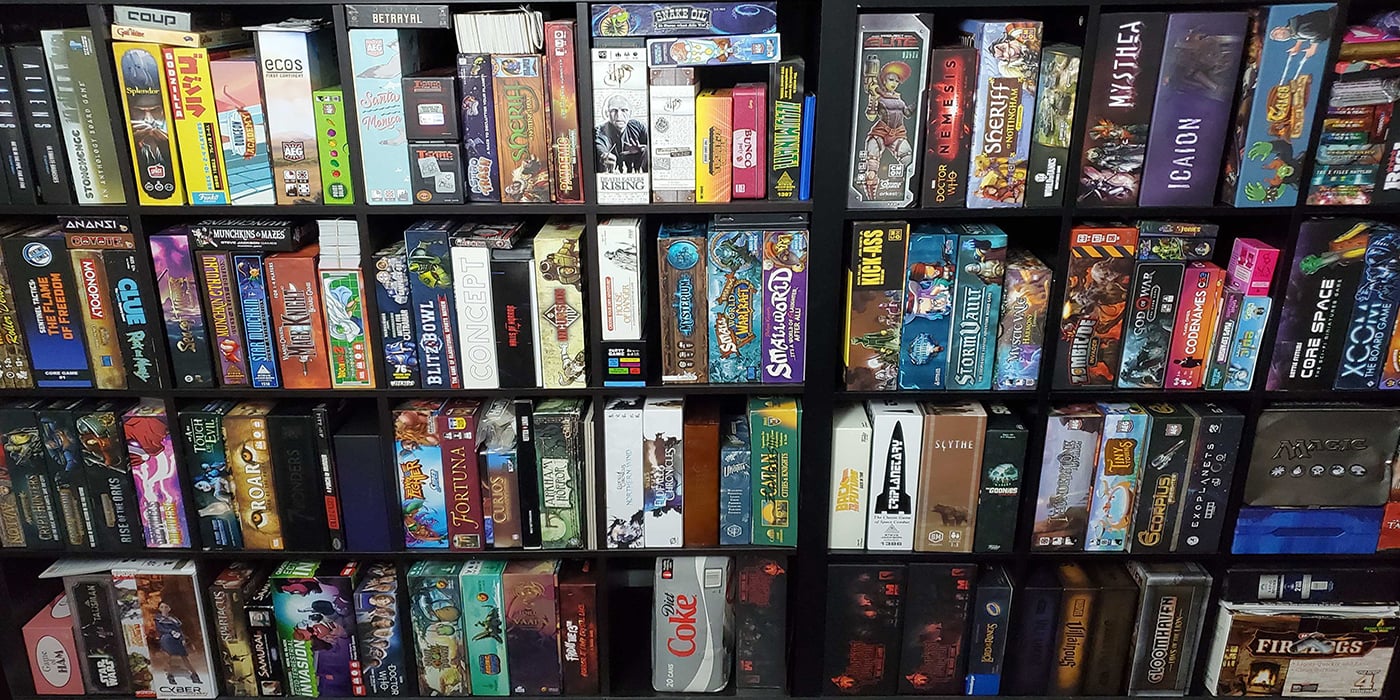
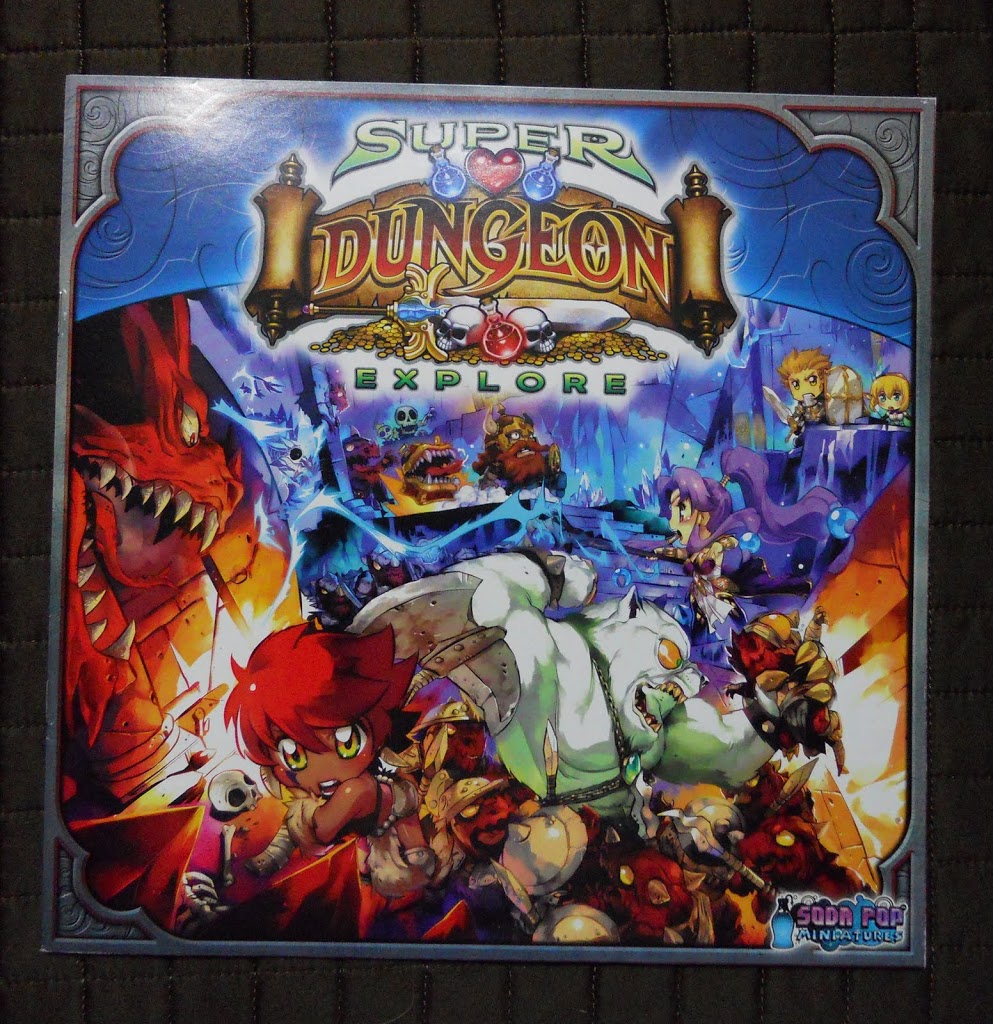 It’s been a long wait for Super Dungeon Explore. It turned a lot of heads at GenCon 2010 with miniatures that had a chibi style no one had seen in a game before. People were so excited about the minis that metal casts of them were selling long before the game itself was available.
It’s been a long wait for Super Dungeon Explore. It turned a lot of heads at GenCon 2010 with miniatures that had a chibi style no one had seen in a game before. People were so excited about the minis that metal casts of them were selling long before the game itself was available.
So what is it? Super Dungeon Explore is a dungeon crawl board game inspired by the 8-bit video games a lot of us played as kids. This thematic influence is carried into all of its aspects including the rules, game play, and (obviously) the aesthetics. I hope everyone likes pictures because here we go.
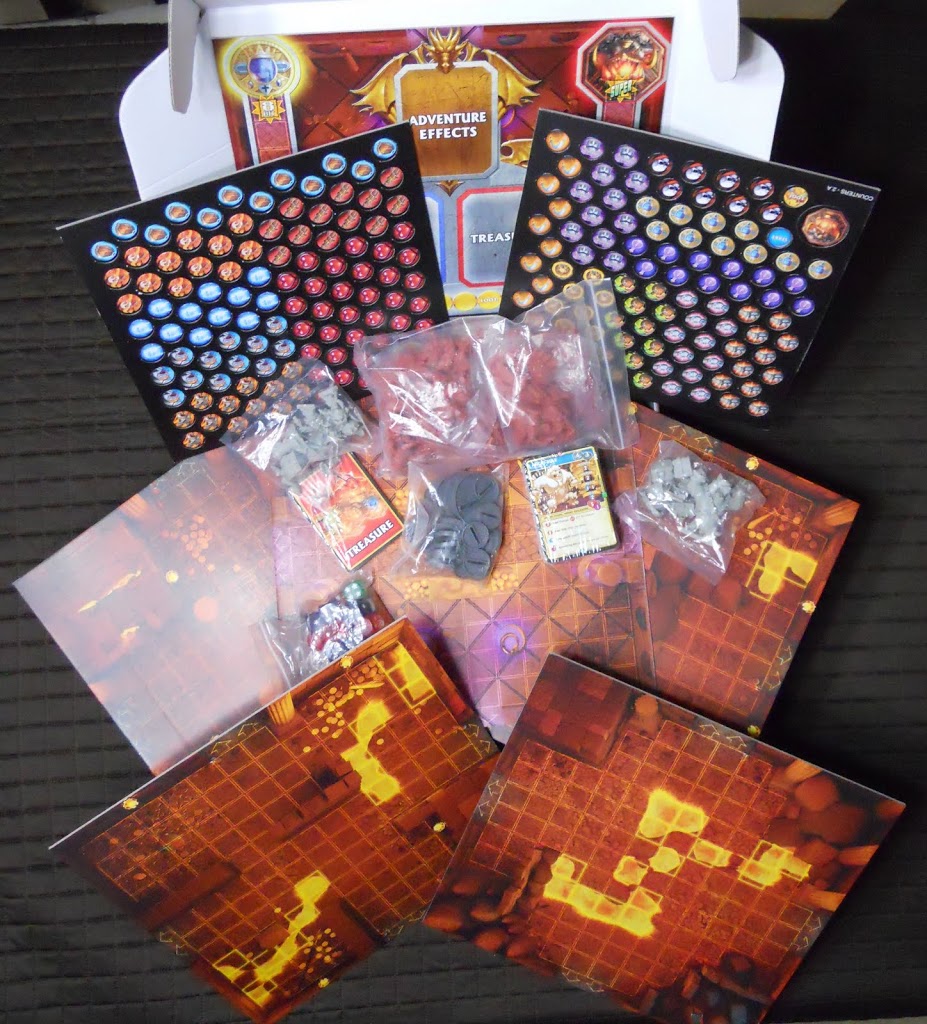 The box is loaded with stuff. Super Dungeon Explore delivers a lot for its $89.99 MSRP.
The box is loaded with stuff. Super Dungeon Explore delivers a lot for its $89.99 MSRP.
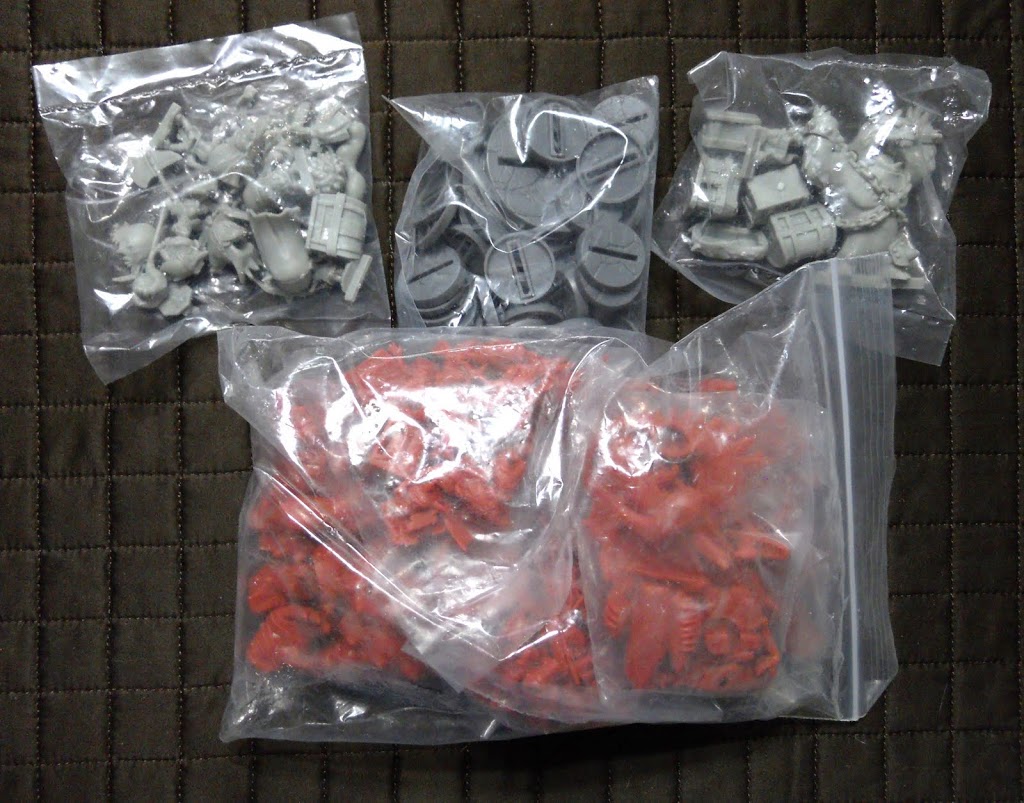 To start with, the game comes with over 50 minis.
To start with, the game comes with over 50 minis.
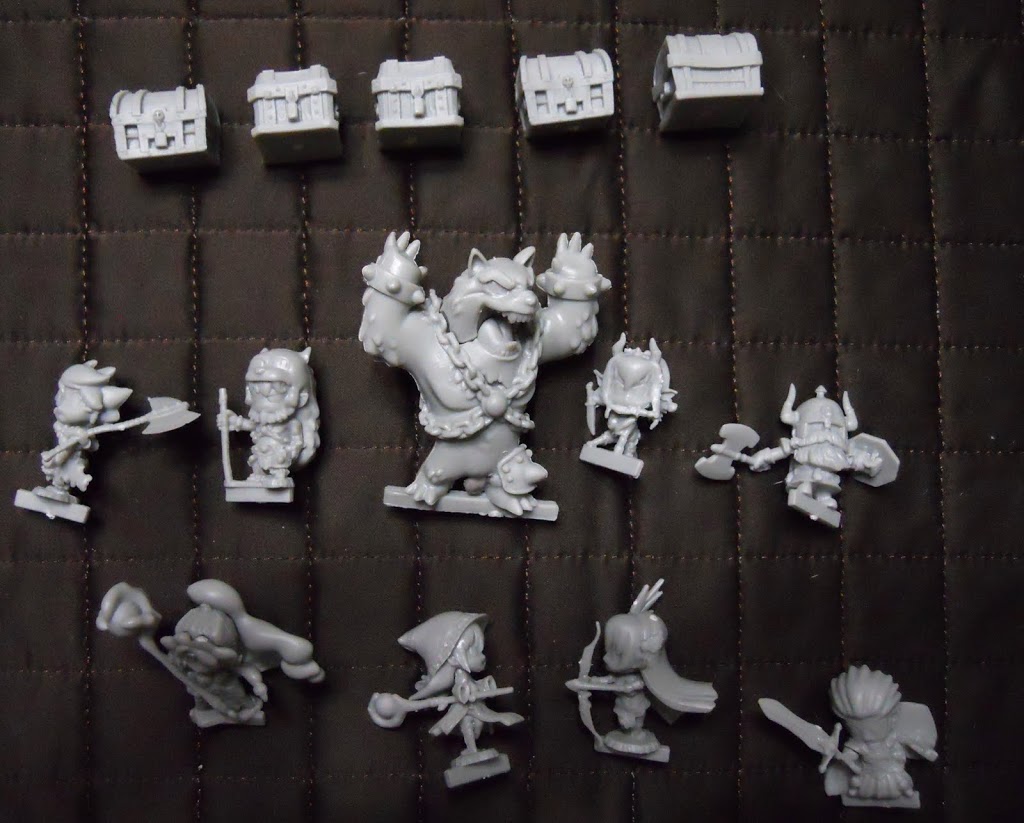 Nine of them are heroes. The druid (2nd row, 2nd from left) is a shapeshifter who transforms into the bear giving you Eight playable characters. With what comes in the box you can play a game with between 2 and 6 players. I’m sure this will only increase as expansions are released. One player will need to take the role of the consul and it will be their task to spawn and control the monsters. The rest will command the heroes. There are also 5 treasure chests from which your heroes can acquire powerful artifacts.
Nine of them are heroes. The druid (2nd row, 2nd from left) is a shapeshifter who transforms into the bear giving you Eight playable characters. With what comes in the box you can play a game with between 2 and 6 players. I’m sure this will only increase as expansions are released. One player will need to take the role of the consul and it will be their task to spawn and control the monsters. The rest will command the heroes. There are also 5 treasure chests from which your heroes can acquire powerful artifacts.
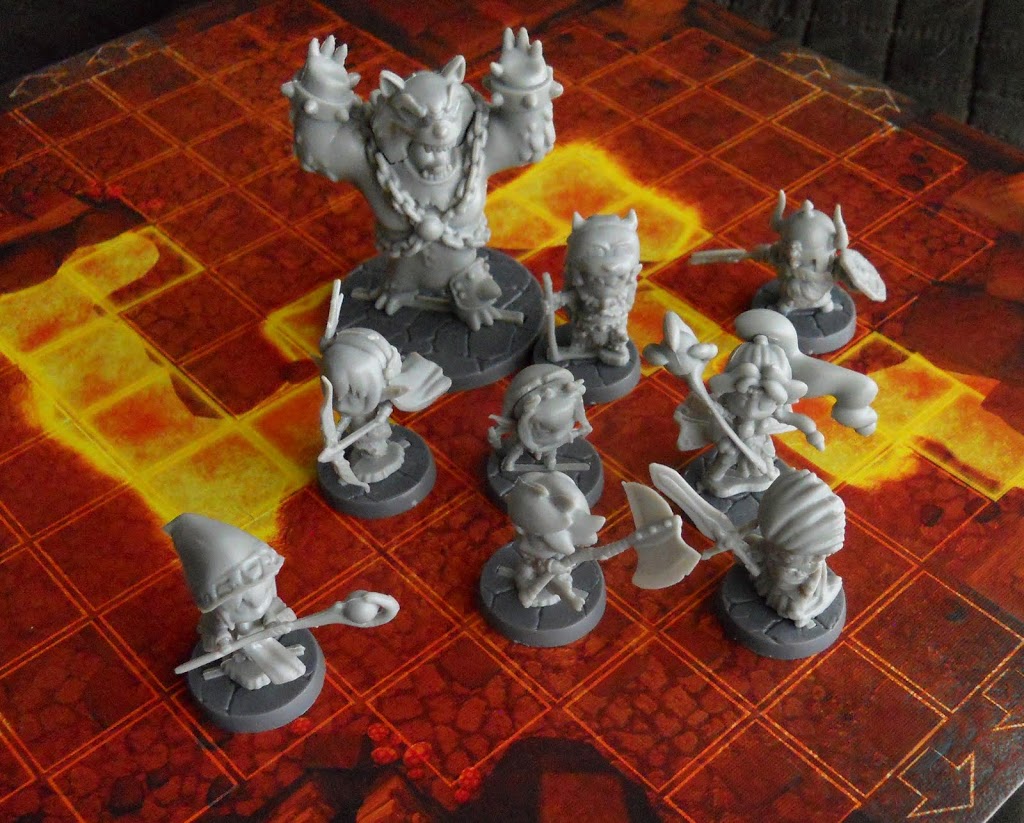 There are modes set up for 2, 3, and 5 heroes, so you get a different experience depending on how many players or how much time you have. And of course there’s no reason why one player can’t control multiple heroes or even all of them if you don’t otherwise have enough people to get to the size you want to play. The heroes all have different stats and abilities. Some heal, some are good with crowds, and others hit really hard. There are even some good hybrid classes. You’ll need to think hard about which you bring along.
There are modes set up for 2, 3, and 5 heroes, so you get a different experience depending on how many players or how much time you have. And of course there’s no reason why one player can’t control multiple heroes or even all of them if you don’t otherwise have enough people to get to the size you want to play. The heroes all have different stats and abilities. Some heal, some are good with crowds, and others hit really hard. There are even some good hybrid classes. You’ll need to think hard about which you bring along.
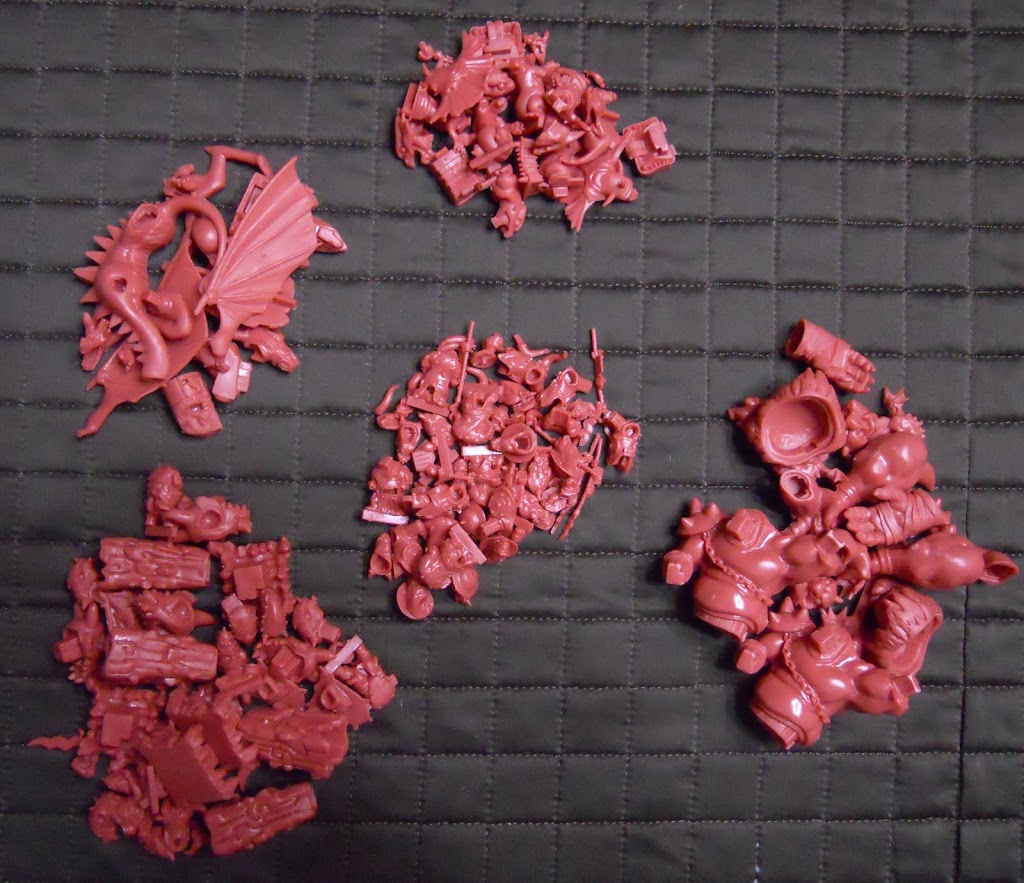
The consul player gets a lot of cool monsters to choose from. This first set has an emphasis on kobolds and dragon spawn. There are five different types of Kobold Minions, three types of Drake Denizens, a Kobold Ogre Mini Boss, and a Dragon Boss.
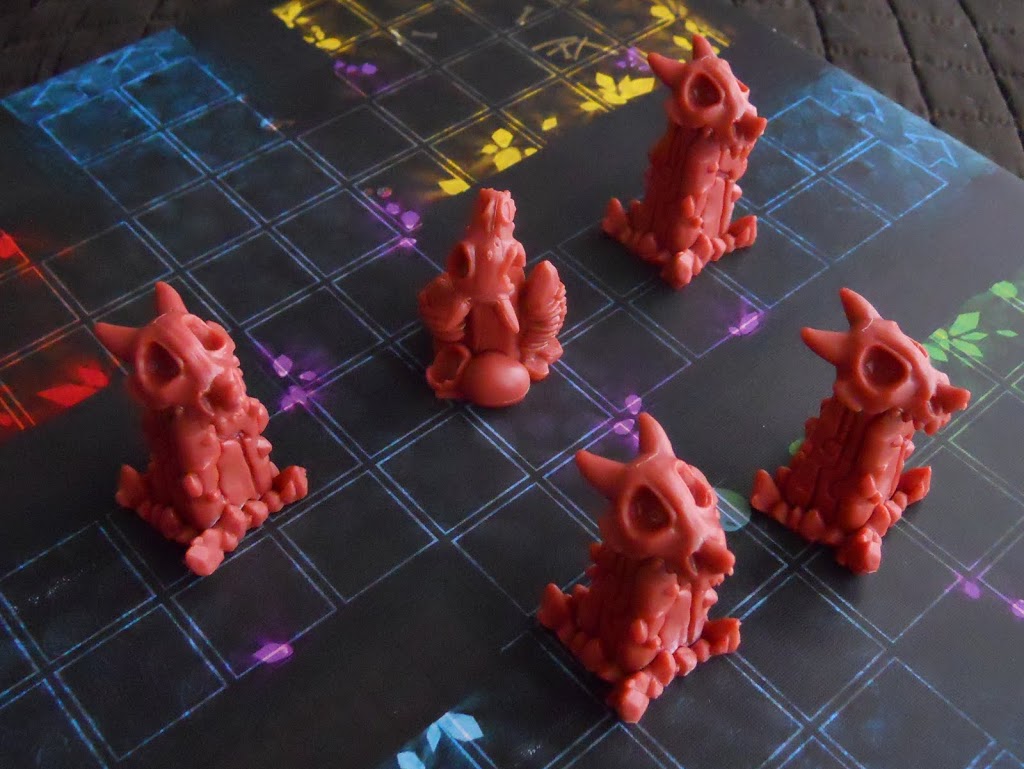 The consul will be spawning his monsters through these nodes. These are your heroes’ primary targets, since eliminating all of them will cause the boss to spawn. They’ll need to defeat him to win the game. And if they can’t get their act together and the boss appears with these nodes still in play he’ll be extra powerful.
The consul will be spawning his monsters through these nodes. These are your heroes’ primary targets, since eliminating all of them will cause the boss to spawn. They’ll need to defeat him to win the game. And if they can’t get their act together and the boss appears with these nodes still in play he’ll be extra powerful.
A Monster’s power is measured in skulls, and up to four skulls worth of monsters may be spawned from each node per turn – more if the consul gets a hold of some skull counters. The nodes shown here are the only two types that come in the base game: Kobold Warrens and an Egg Clutch (center). Each type provides the consul player with a different assortment of monsters to add to his spawning pool. You don’t have to bring a monster type in through the spawning point it came with. Warrens can spawn dragons, and Egg Clutches can spawn kobolds. But if you lose all of a certain kind of node you can’t regenerate any of its monster type any more. You can also only put in one spawning point per Dungeon Tile, so don’t expect to see a situation like the one above in an actual game.
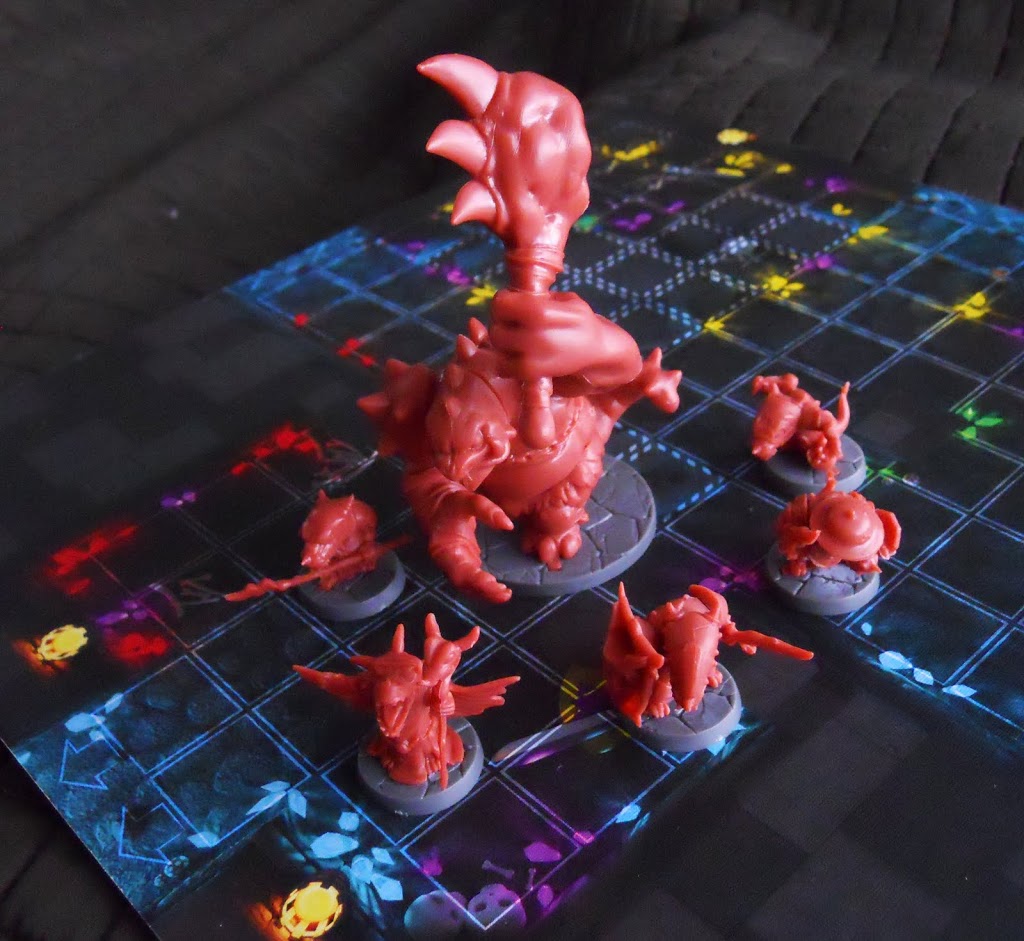
Just like with the heroes, the different monsters have different abilities and different stats. The Kobolds (and Minions in general according to the rules) fight better in large numbers, and their more elite fighters have some great auras they can pick as well.
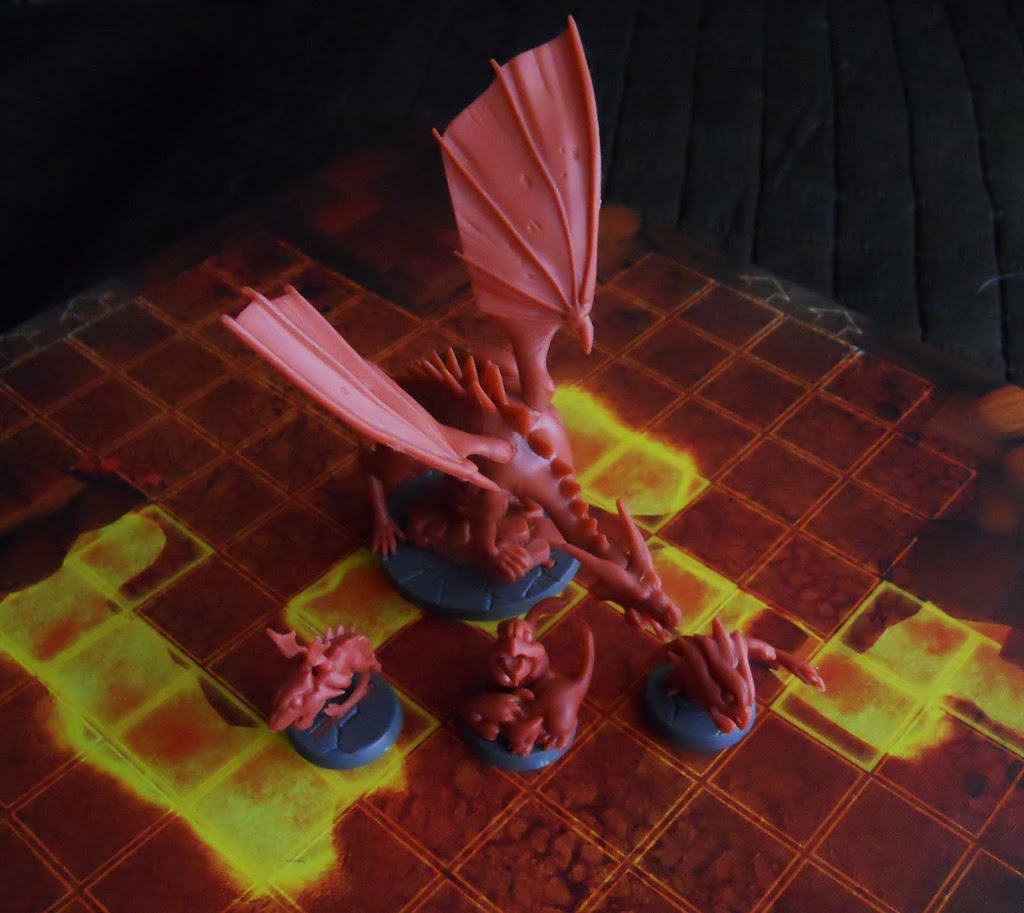 As Denizens, the dragon-themed monsters are generally a bit more powerful. Their abilities are also more active. Some of them have the ability to knock a hero down, while another might get a big bonus for attacking a knocked down model.
As Denizens, the dragon-themed monsters are generally a bit more powerful. Their abilities are also more active. Some of them have the ability to knock a hero down, while another might get a big bonus for attacking a knocked down model.
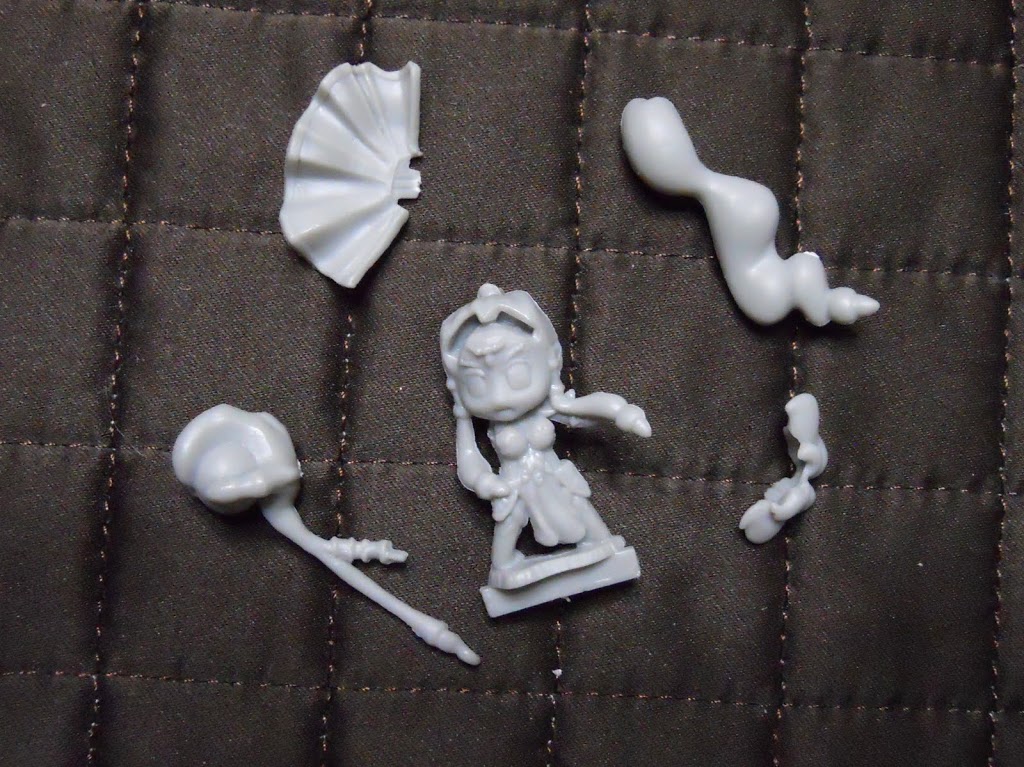 A lot of the minis are rather complex with multiple pieces. But they are very well thought out, with each piece having a corresponding hole that only it will fit into. This made assembly pretty easy even without any instructions included.
A lot of the minis are rather complex with multiple pieces. But they are very well thought out, with each piece having a corresponding hole that only it will fit into. This made assembly pretty easy even without any instructions included.
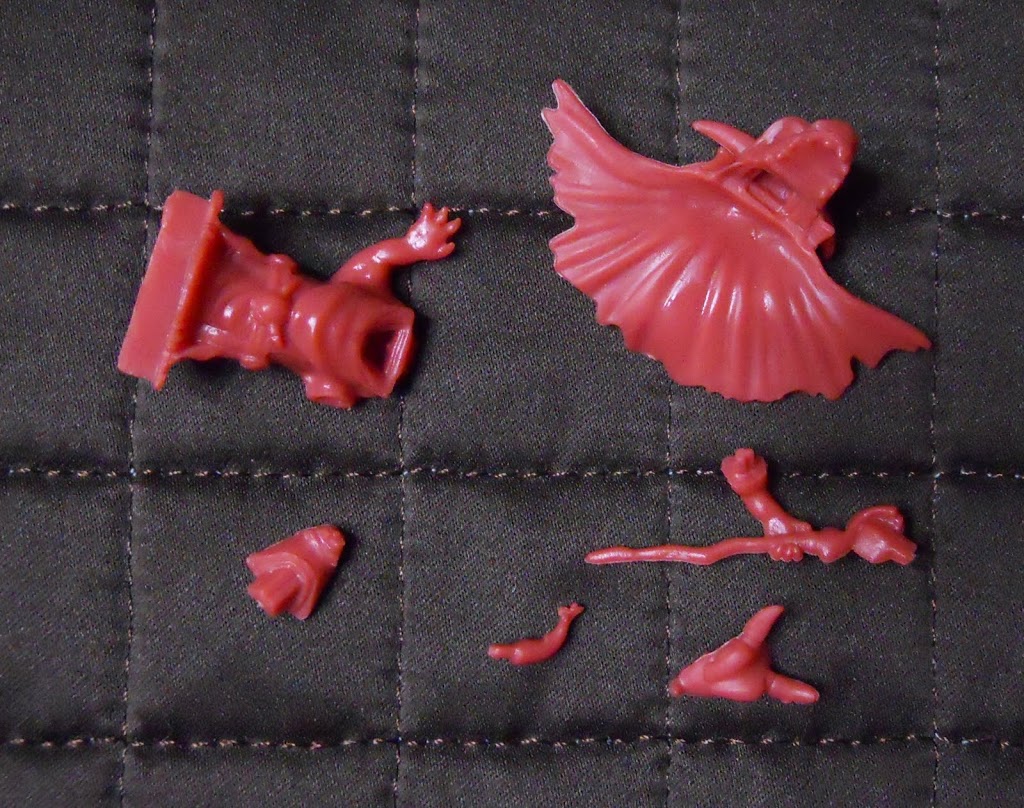 As you can see there are some really tiny pieces. Four out of the five kobold sculpts have individual tails. I was pretty blown away that with all these little parts, my copy of Super Dungeon Explore wasn’t missing one single piece.
As you can see there are some really tiny pieces. Four out of the five kobold sculpts have individual tails. I was pretty blown away that with all these little parts, my copy of Super Dungeon Explore wasn’t missing one single piece.
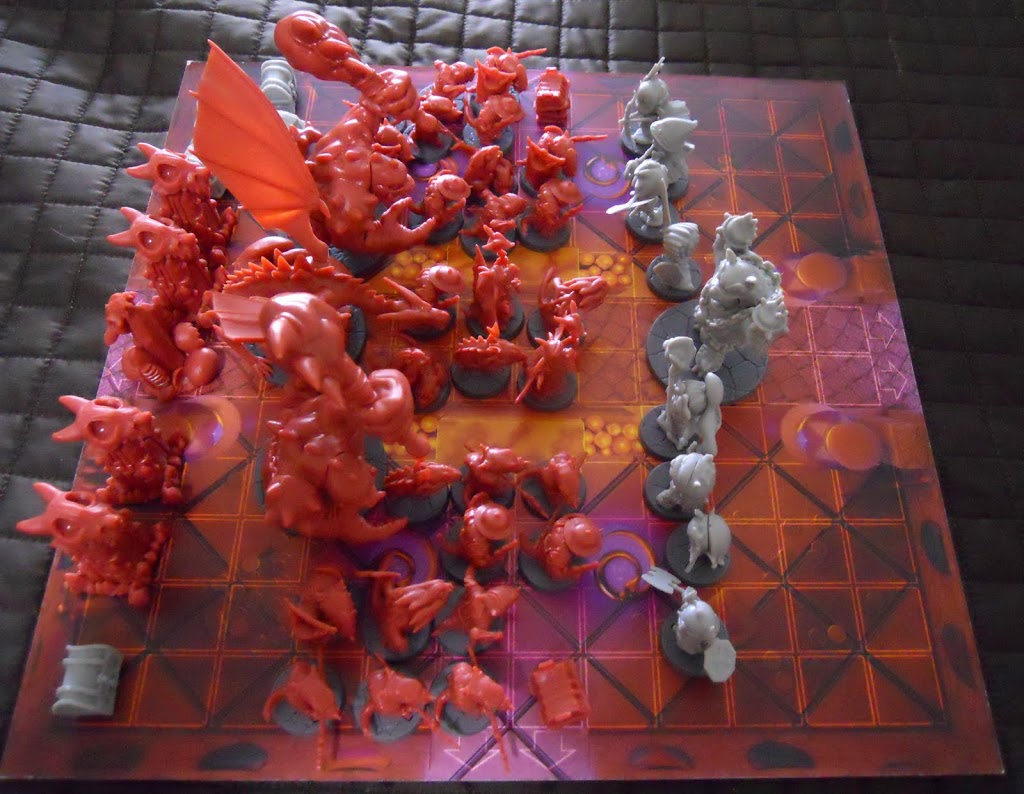
And here you can see all the models that come in just one set. They’re all very high quality too. Much more than what you might expect from a board game.
 All the combats in the game will use these custom dice. A model’s stats are measured by the number and type of dice they roll. The attacking player and defending player roll their attack and armor stats and the player with the most star results succeeds; scoring a hit or defending respectively. Red dice have more stars in total than the blue dice, so are more likely to yield successes. But each die also has the chance to yield a certain resource if a wound is caused and a resource is rolled. The blue dice might be “weaker” but they always have the chance to roll a Heart and heal a wound from a member of the party. The red dice can give you Potions which let your heroes use really powerful abilities. The green dice are patently better with the most stars and the option to choose between a Potion or a Heart. The heroes will need both resources if they are going to conquer the dungeon. Only heroes can use these resources, and only when attacking. Hearts and Potions rolled when defending count as blank faces.
All the combats in the game will use these custom dice. A model’s stats are measured by the number and type of dice they roll. The attacking player and defending player roll their attack and armor stats and the player with the most star results succeeds; scoring a hit or defending respectively. Red dice have more stars in total than the blue dice, so are more likely to yield successes. But each die also has the chance to yield a certain resource if a wound is caused and a resource is rolled. The blue dice might be “weaker” but they always have the chance to roll a Heart and heal a wound from a member of the party. The red dice can give you Potions which let your heroes use really powerful abilities. The green dice are patently better with the most stars and the option to choose between a Potion or a Heart. The heroes will need both resources if they are going to conquer the dungeon. Only heroes can use these resources, and only when attacking. Hearts and Potions rolled when defending count as blank faces.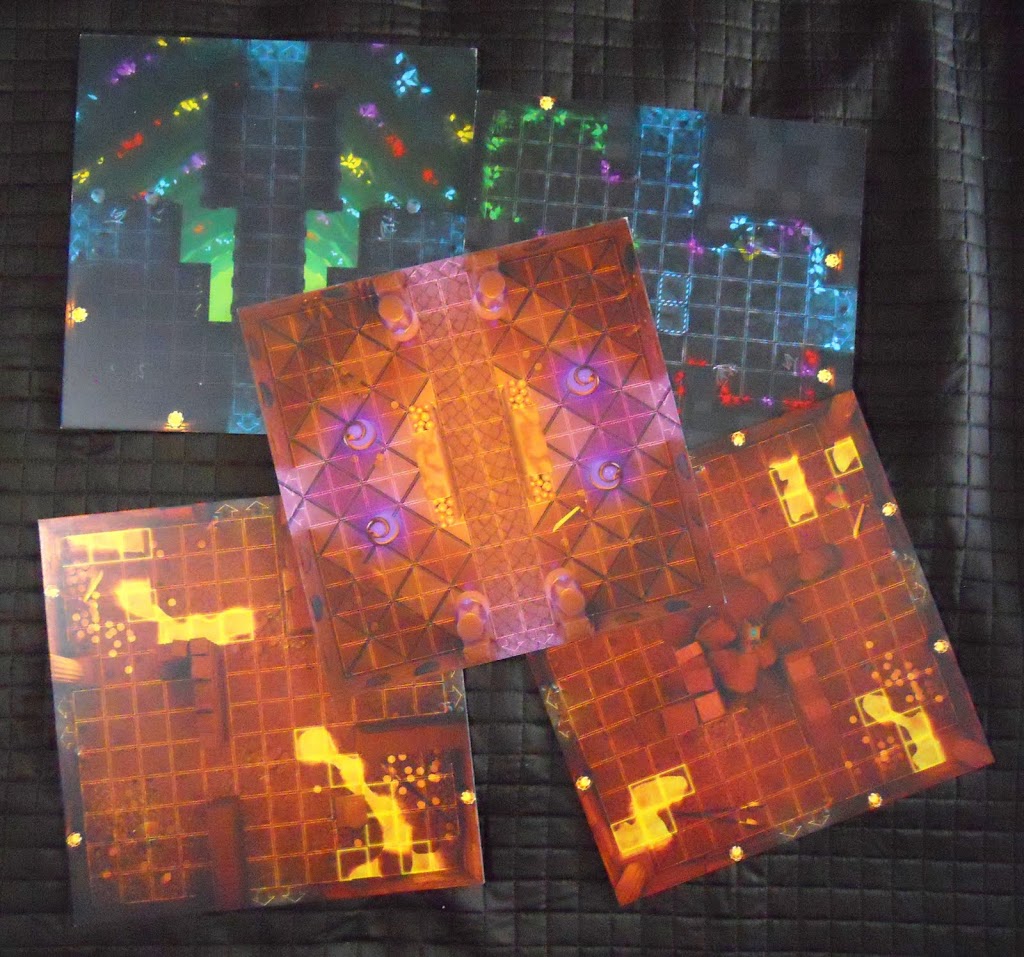 There’s 5 double-sided Dungeon tiles for the heroes to explore. Each tile has different terrain layouts including difficult terrain, hazardous terrain that will set you on fire, and the usual walls and obstacles that are impassable.
There’s 5 double-sided Dungeon tiles for the heroes to explore. Each tile has different terrain layouts including difficult terrain, hazardous terrain that will set you on fire, and the usual walls and obstacles that are impassable.
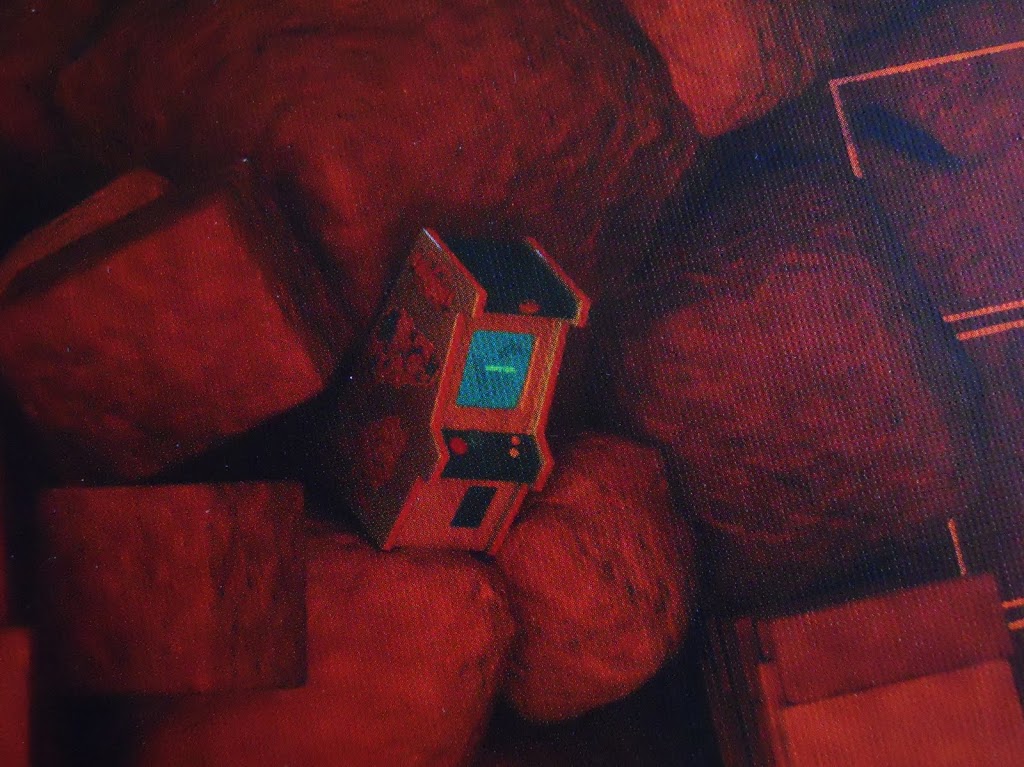 The tile art has some cool little Easter Eggs like this arcade game console here.
The tile art has some cool little Easter Eggs like this arcade game console here.
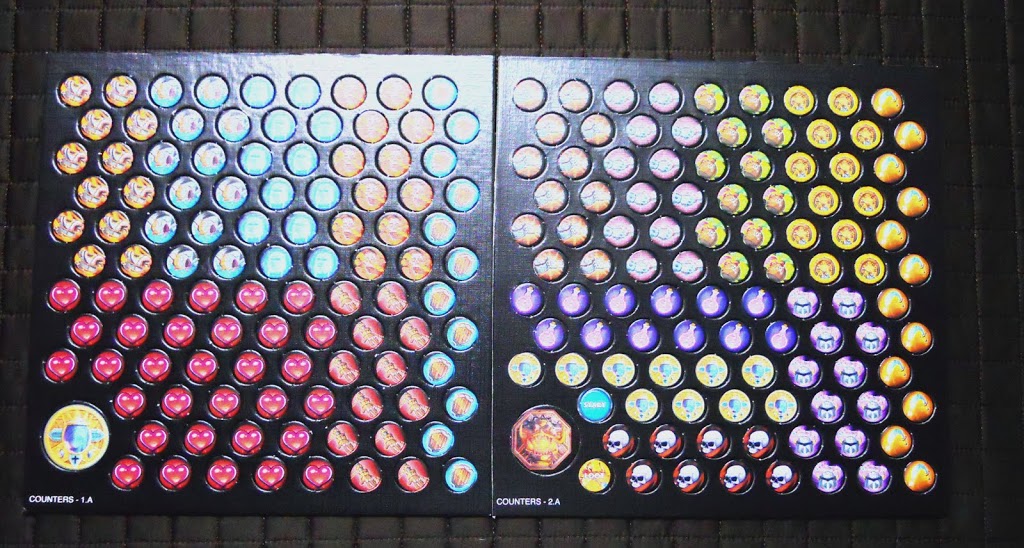
There are a lot of in-game effects and the game provides plenty of counters to keep track of them all.
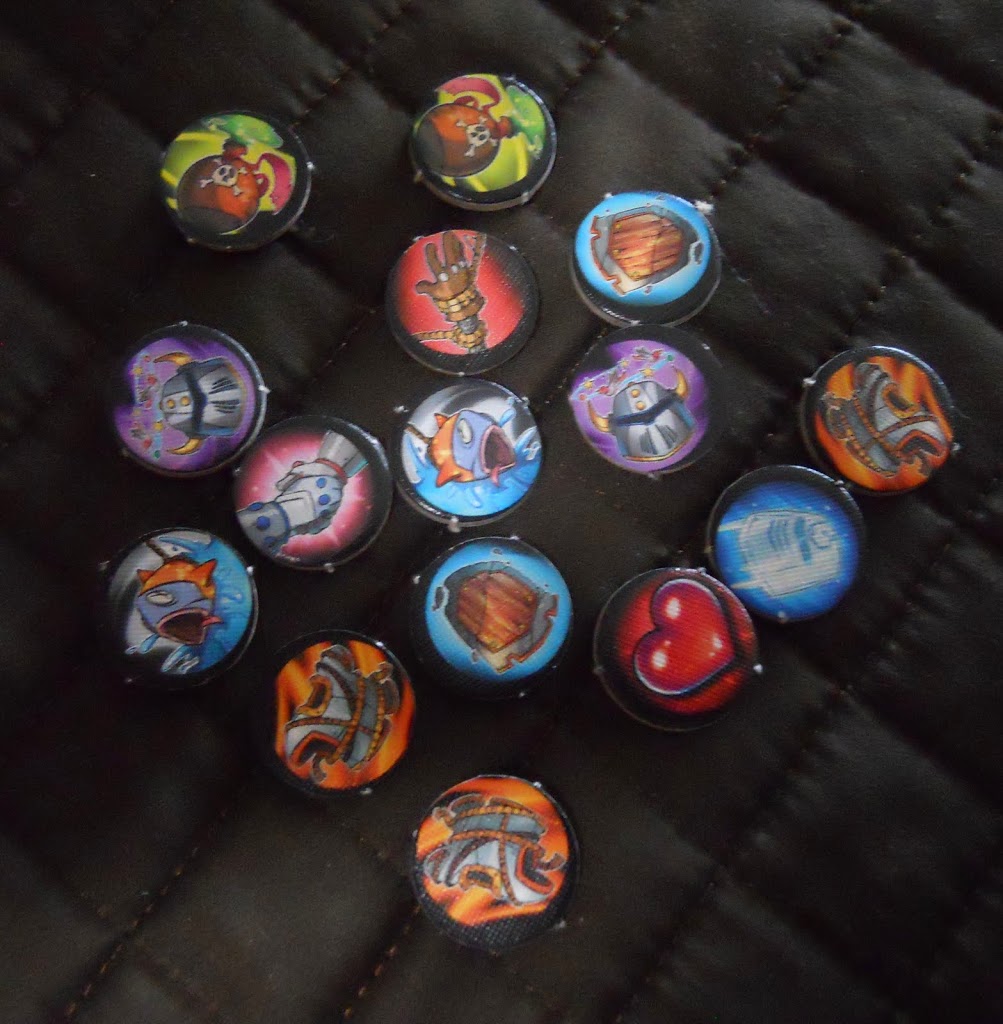 The art on the counters is really high quality. Here we have Poison, Immobile, Fragile, Stun, Pacify, Choke, Cold, Bind, and a wound counter.
The art on the counters is really high quality. Here we have Poison, Immobile, Fragile, Stun, Pacify, Choke, Cold, Bind, and a wound counter.
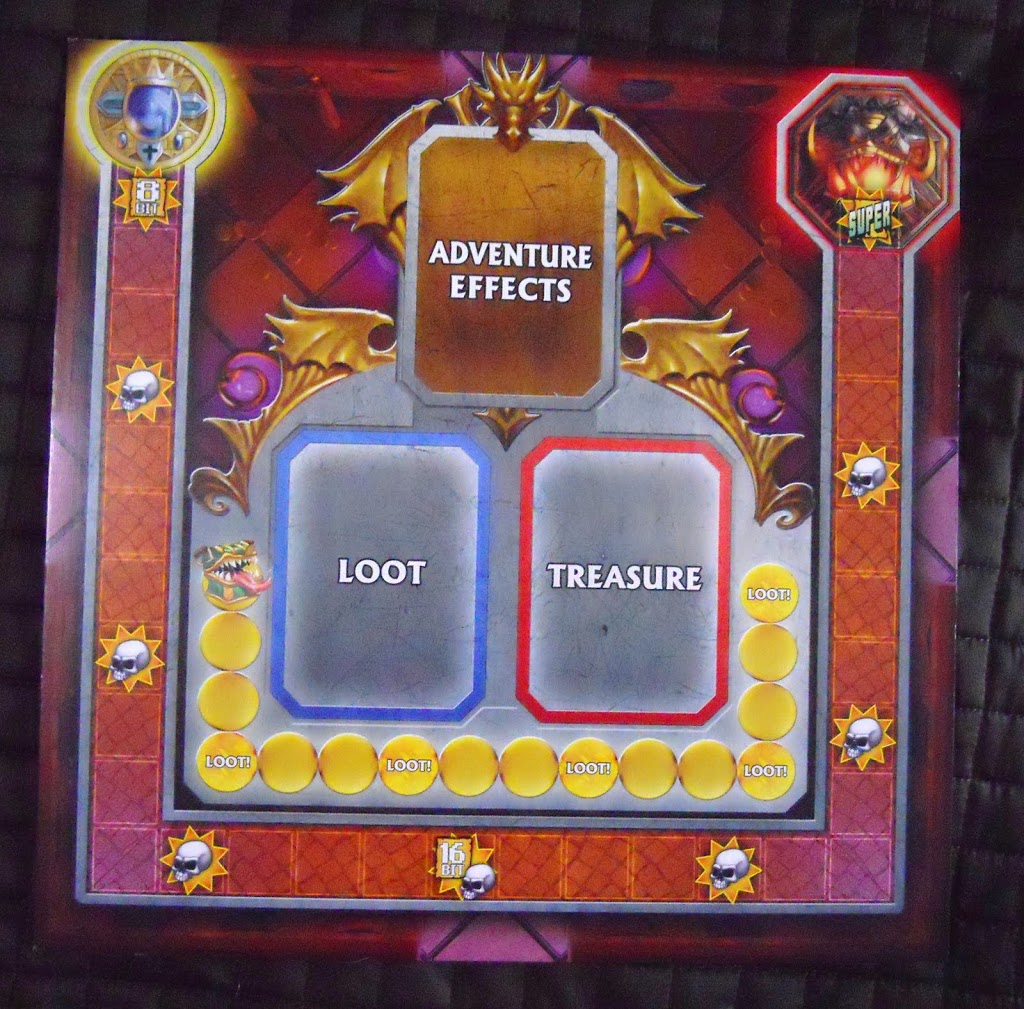
The Adventure Tracker tile here keeps track of bonuses for the heroes and the consul while providing a handy place to put your Loot, Lreasure, and Adventure Effects cards. The hero player/s get to move the loot counter along the inner track one space for each wound they cause. Each time a loot space is reached the heroes get a Loot Card to use next turn. The Loot meter resets each turn. The outer track is the Power Gauge. Whenever any wounds are caused the Power Gauge advances one space. For every skull space reached the consul player gets a Skull Counter allowing them to spawn an extra skull worth of monsters in the following turn. The Power Gauge also determines when the consul player gets to spawn mini bosses and, if the heroes don’t destroy the spawning points in time, the final boss monster.
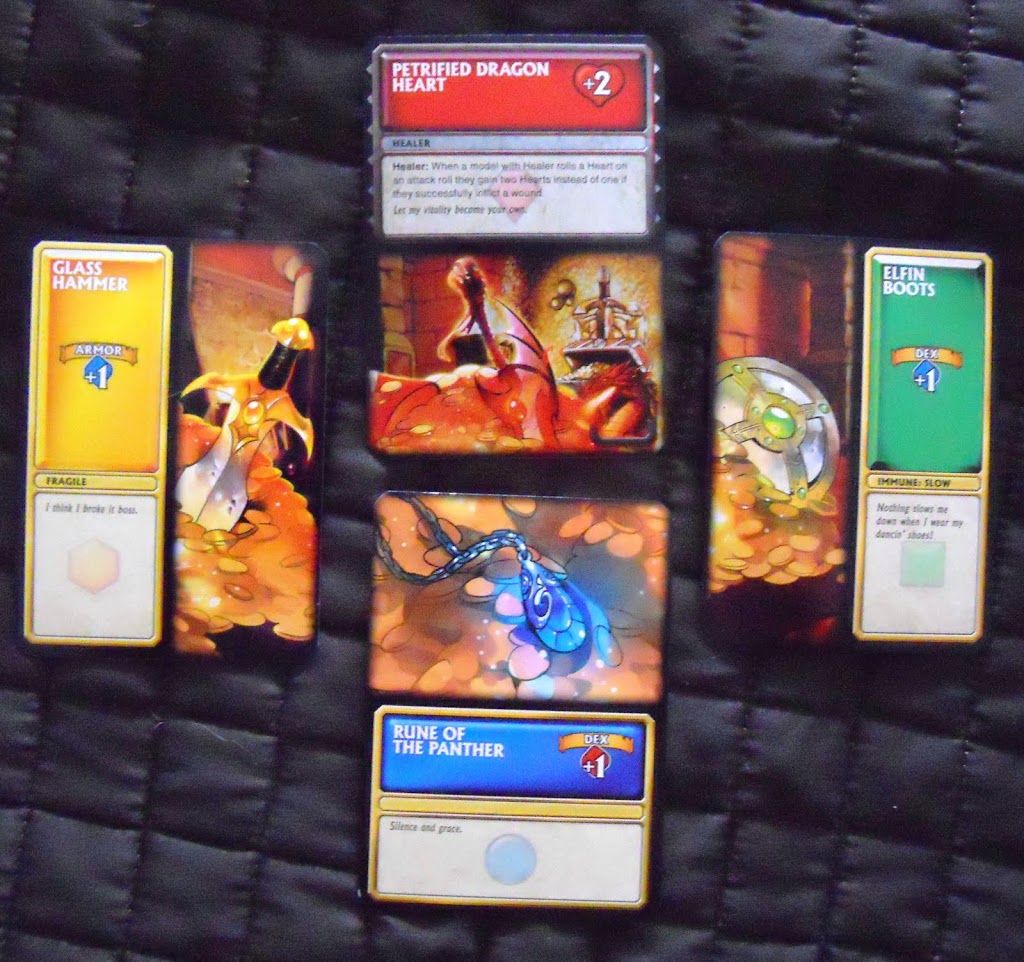 And speaking of loot, here are some loot cards. The yellow, blue, and green types are acquired by advancing the loot meter. The red artifacts (top) will be found in treasure chests or dropped when mini-bosses are defeated. At the end of the turn the heroes get to decide who gets what loot. But since different stats will be helpful to different character types, it shouldn’t be that hard to agree on who who gets what. You’ll also want to make sure your party includes characters that can benefit from different stats. Spell casters will want more Will, ranged attackers will want more Dex, and melee fighters will want more Attack. If you don’t have heroes who can use different stat types, you’ll end up turning a lot of unused loot into potions.
And speaking of loot, here are some loot cards. The yellow, blue, and green types are acquired by advancing the loot meter. The red artifacts (top) will be found in treasure chests or dropped when mini-bosses are defeated. At the end of the turn the heroes get to decide who gets what loot. But since different stats will be helpful to different character types, it shouldn’t be that hard to agree on who who gets what. You’ll also want to make sure your party includes characters that can benefit from different stats. Spell casters will want more Will, ranged attackers will want more Dex, and melee fighters will want more Attack. If you don’t have heroes who can use different stat types, you’ll end up turning a lot of unused loot into potions.
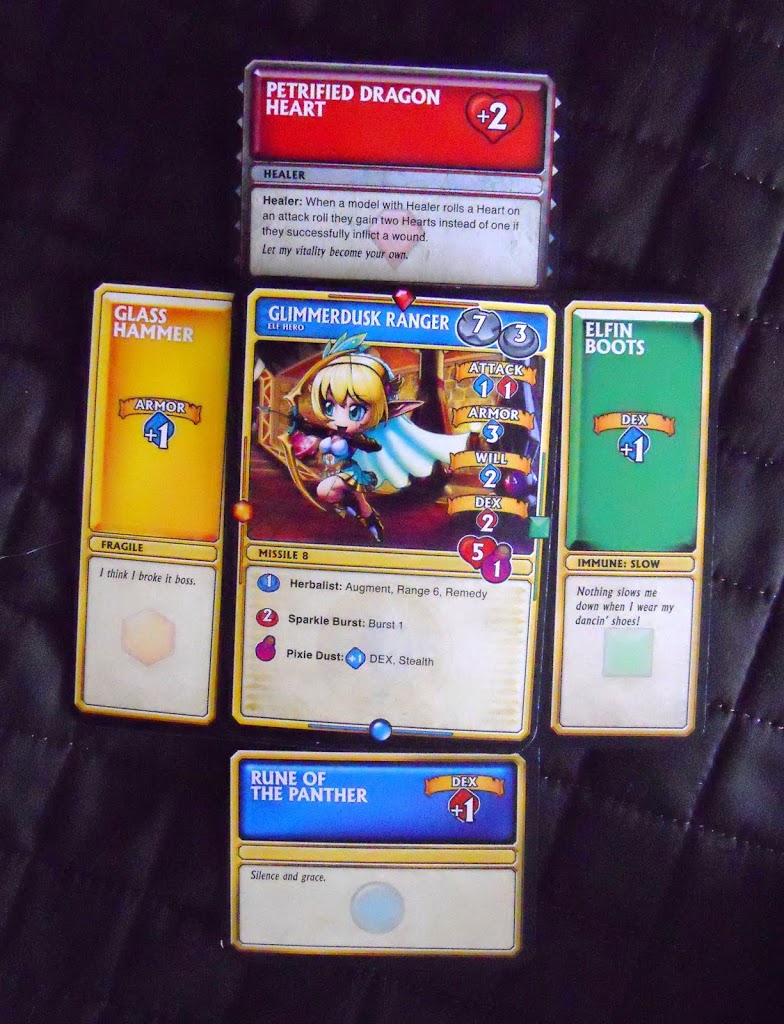 One of my favorite things about this game is the “inventory slot” system the cards use. You tuck your loot cards under your character card meaning a fully equipped character looks like this. It’s a clever design trick I’ve never seen any other game use before.
One of my favorite things about this game is the “inventory slot” system the cards use. You tuck your loot cards under your character card meaning a fully equipped character looks like this. It’s a clever design trick I’ve never seen any other game use before.

Here are some more cards to look at. All the heroes, a few monsters, and some other treasures and loot.And this is hardly all the cards. The game has a lot more than I could cram into one picture.
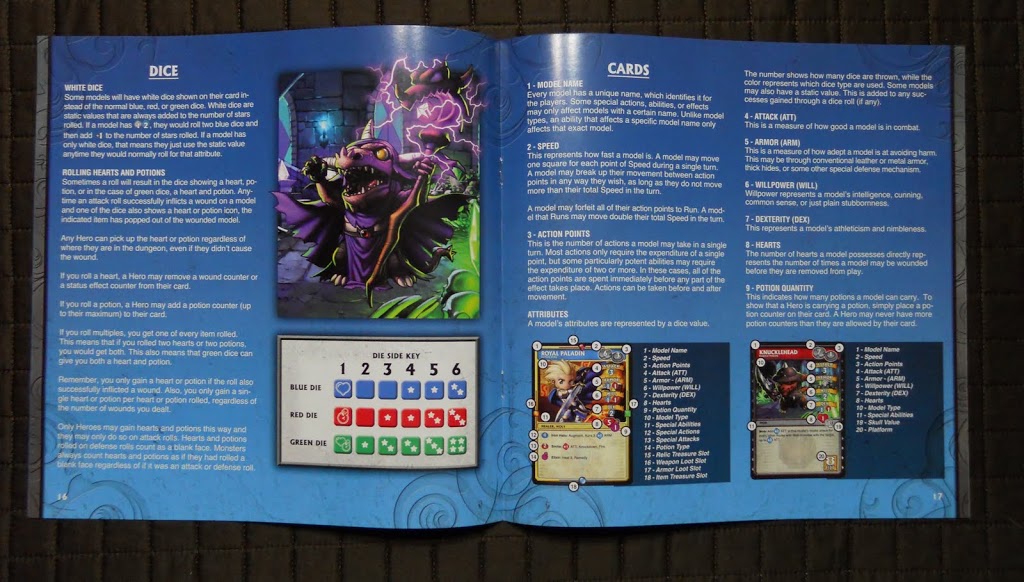 And here’s a look at the rules. They are remarkably clear, especially when compared to some other board games I’ve seen. I’ve already played multiple games with no real hang-ups to resolve. The only thing that doesn’t seem to be well explained is the definition of a “room.” I’m pretty sure each tile is divided into four rooms by two intersecting 2-square-wide hallways running down the middle. But I can’t find anywhere that actually says so. Still, using that definition has been more than enough to get some games rolling. And speaking of which…
And here’s a look at the rules. They are remarkably clear, especially when compared to some other board games I’ve seen. I’ve already played multiple games with no real hang-ups to resolve. The only thing that doesn’t seem to be well explained is the definition of a “room.” I’m pretty sure each tile is divided into four rooms by two intersecting 2-square-wide hallways running down the middle. But I can’t find anywhere that actually says so. Still, using that definition has been more than enough to get some games rolling. And speaking of which…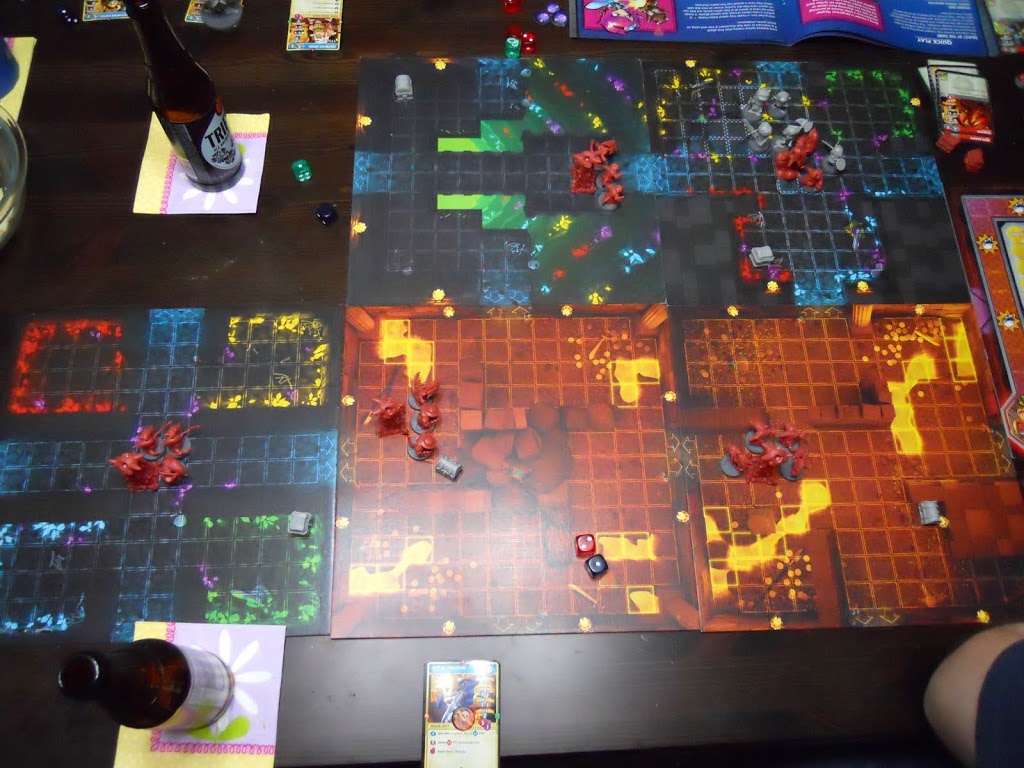
Here’s turn 1 of our first 5 hero game. Our consul made a rookie mistake by putting the spawning points in the center of the tiles. This meant we got to destroy the Egg Clutch on the first turn and didn’t have to worry about any Drake Denizens bothering us until the Boss appeared and spawned some more much later on. I think this one mistake made the heroes’ jobs a lot easier. I’m pretty sure from now on we can expect to see all the Spawning Points tucked away in the inner corners of all the Dungeon tiles.
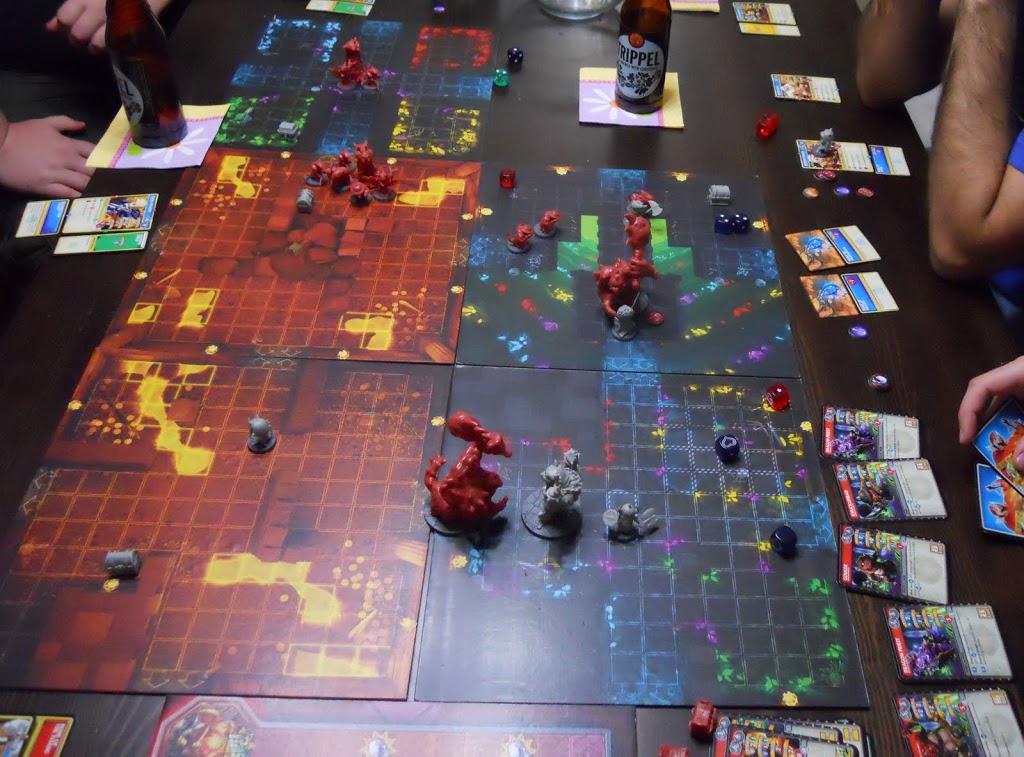 Soon after, the Rogue used her potion to blink across the room and take out another spawning point.
Soon after, the Rogue used her potion to blink across the room and take out another spawning point.
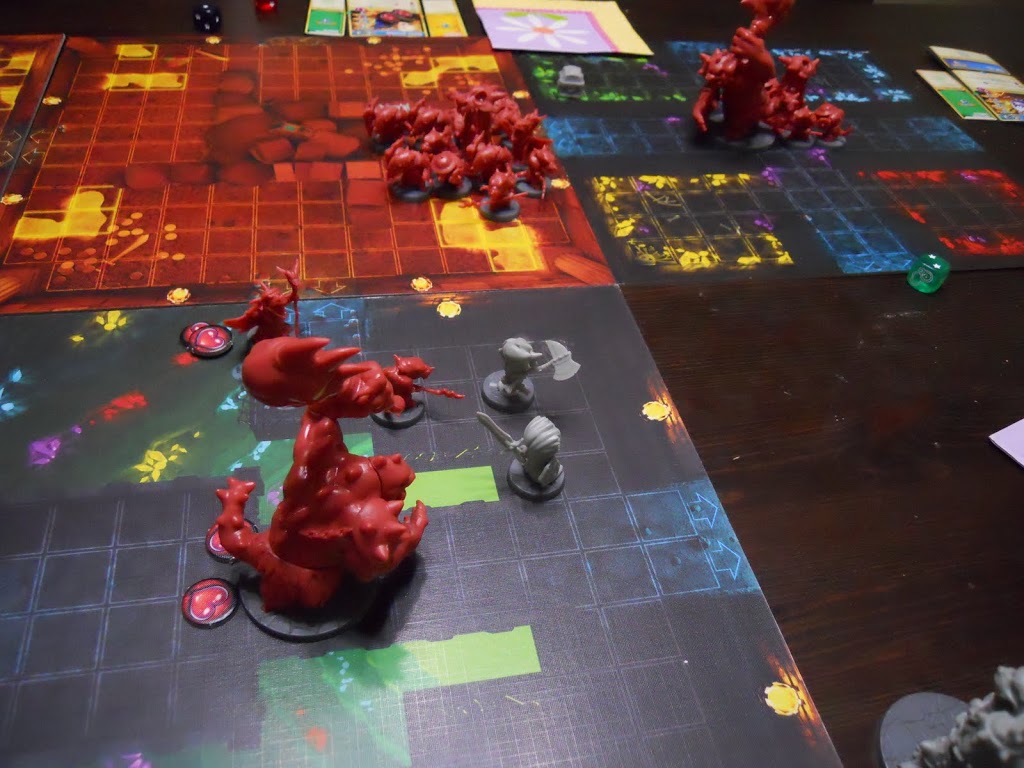
The Barbarian and Paladin took out another one, but got separated from the group almost losing the party the aid of a powerful healer. Fortunately the dice shined on the heroes and the two survived despite the odds.
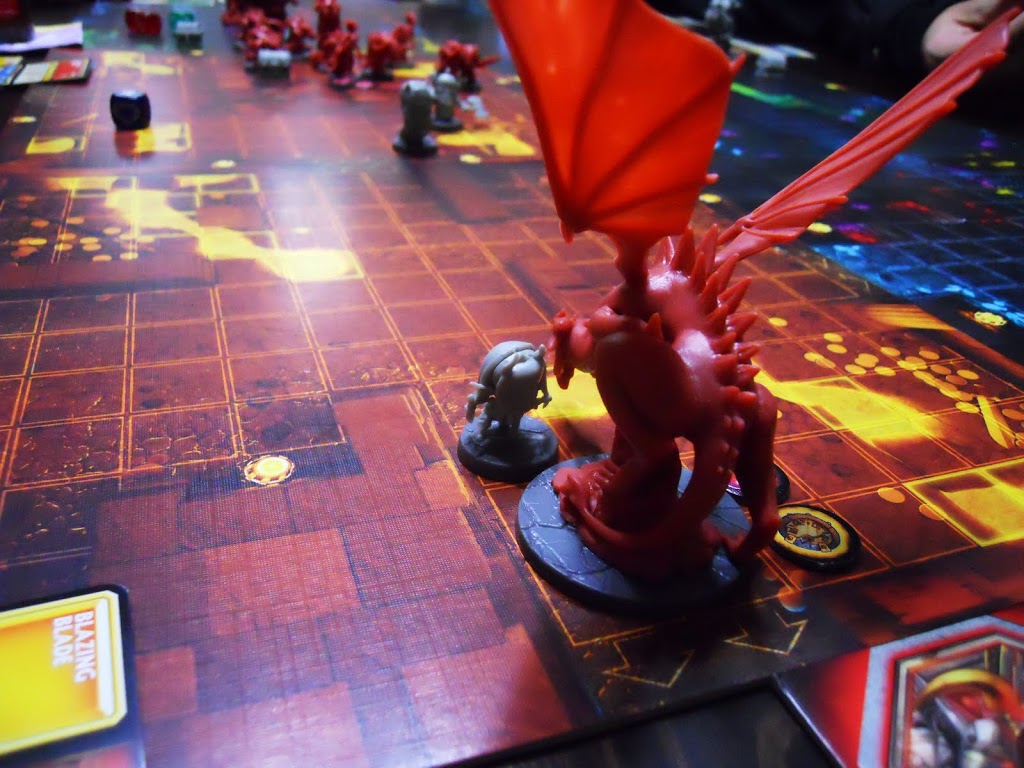
By this time, the heroes had caused enough damage that the Boss appeared. The Rogue can make a great agility tank using her Dex rather than armor for defense rolls. Since there were no ranged attackers in the party to use the Dex loot we got, the rogue ended up with all of it. With so many dice to defend with, she wasn’t afraid to go straight for the dragon. Her poisoned daggers managed to inflict it with the slow status effect, buying the rest of the heroes time to finish off the remaining spawn points.
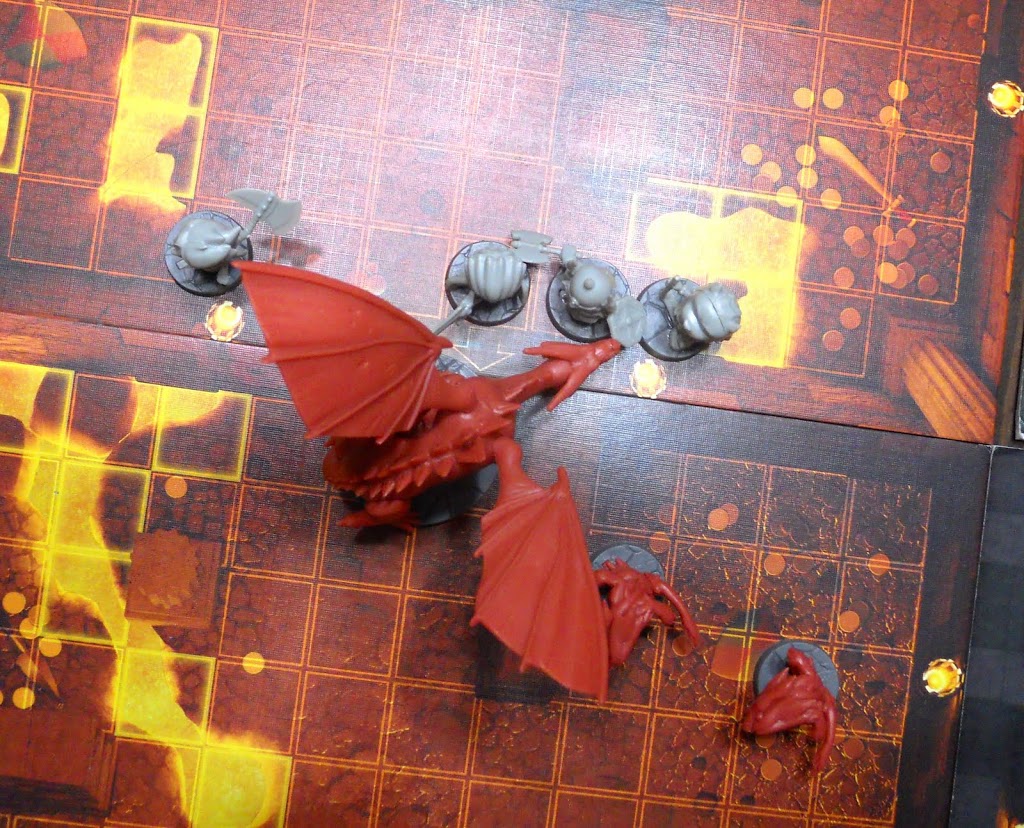 Once they cleaned up the riff-raff, the heroes were able to focus all their attention on the Dragon and bring it down.
Once they cleaned up the riff-raff, the heroes were able to focus all their attention on the Dragon and bring it down.
This game has been a real hit with everyone who’s played it. Two people who’ve played it have already pre-ordered themselves a copy, and everyone else is talking about doing the same. If this looks like something you’d enjoy, I’d advise that you don’t wait to order yours. I think the first printing will probably sell out in a hurry.
All sunshine aside, I do have a single bit of criticism of this product. I am foremost a minis gamer, so it was of very little consequence for me to put this set together. In fact, when I brought it in to the LGS to show off, everyone was so excited to see it I ended up with four people helping me assemble it. But there is no indication on the box of the level of detail of these pieces. They will require super glue to hold together properly, and this could lead to a big shock for a board gamer who isn’t used to dealing with miniatures. Some sort of warning for these folks would probably be appreciated.
~ I think Super Dungeon Explore is definitely a buy. It’s a blast to play and I’m eagerly anticipating my next opportunity to try it out again. If you get the chance to check it out, don’t pass it up. And don’t resist the temptation to grab a copy of your own.

